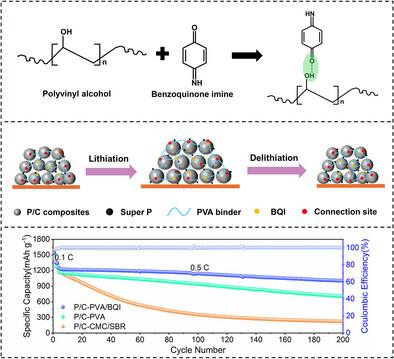醌-亚胺增强PVA粘结剂:Li/ na离子电池中低粘结剂含量高负载电极的通用策略
IF 12.1
2区 材料科学
Q1 CHEMISTRY, MULTIDISCIPLINARY
引用次数: 0
摘要
磷/碳(P/C)复合材料具有比容量高、倍率性能好、电化学可逆性好、材料成本低等优点,是锂/钠离子电池极具潜力的高容量负极材料。然而,在循环过程中,特别是在高活性材料加载时,大的体积变化会阻碍性能。本文介绍了一种由聚乙烯醇(PVA)和苯醌亚胺(BQI)通过丰富的分子间氢键网络交联而成的新型聚合物粘结剂体系。这种粘合剂表现出优异的动态粘弹性,在循环过程中有效地适应显著的表面积变化和活性物质颗粒的相对运动。强附着力确保所有电极组件之间的牢固结合,包括集流器。PVA具有固有的柔韧性和弹性,而BQI提高了拉伸强度和模量,提高了离子电导率,并促进了导电碳在电极内更均匀分布的更好的润湿性。以5 wt%的粘结剂负载制备的P/C电极,其面容量为10.20 mAh cm - 2,在60次循环后的容量保持率为71.26%,显著优于其他基于粘结剂的P/C阳极。这一进展促进了磷基阳极的实际应用。本文章由计算机程序翻译,如有差异,请以英文原文为准。

Quinone-Imine Enhanced PVA Binder: A Universal Strategy for High-Loading Electrodes With Low Binder Content in Li/Na-Ion Batteries
Phosphorus/carbon (P/C) composites are promising high-capacity anode materials for lithium/sodium-ion batteries due to their high specific capacity, good rate performance, and electrochemical reversibility, coupled with low material cost. However, large volume changes during cycling, especially at high active material loading, hinder performance. This study introduces a novel polymer binder system composed of polyvinyl alcohol (PVA) and benzoquinone imine (BQI), crosslinked through a network of abundant intermolecular hydrogen bonds. This binder exhibits superior dynamic viscoelasticity, effectively accommodating the significant surface area variations and relative movement of active material particles during cycling. The strong adhesion ensures robust bonding between all electrode components, including the current collector. PVA contributes inherent flexibility and elasticity, while BQI enhances tensile strength and modulus, improves ionic conductivity, and promotes better wettability with conductive carbon for a more uniform distribution within the electrode. A P/C electrode prepared with 5 wt% binder loading, exhibiting an areal capacity of 10.20 mAh cm−2, demonstrates a capacity retention of 71.26% after 60 cycles–significantly surpassing other binder-based P/C anodes. This advance promotes the practical application of phosphorus-based anodes.
求助全文
通过发布文献求助,成功后即可免费获取论文全文。
去求助
来源期刊

Small
工程技术-材料科学:综合
CiteScore
17.70
自引率
3.80%
发文量
1830
审稿时长
2.1 months
期刊介绍:
Small serves as an exceptional platform for both experimental and theoretical studies in fundamental and applied interdisciplinary research at the nano- and microscale. The journal offers a compelling mix of peer-reviewed Research Articles, Reviews, Perspectives, and Comments.
With a remarkable 2022 Journal Impact Factor of 13.3 (Journal Citation Reports from Clarivate Analytics, 2023), Small remains among the top multidisciplinary journals, covering a wide range of topics at the interface of materials science, chemistry, physics, engineering, medicine, and biology.
Small's readership includes biochemists, biologists, biomedical scientists, chemists, engineers, information technologists, materials scientists, physicists, and theoreticians alike.
 求助内容:
求助内容: 应助结果提醒方式:
应助结果提醒方式:


